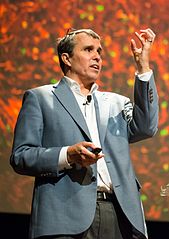Eric Betzig
 | |
| Data i miejsce urodzenia | 13 stycznia 1960 |
|---|---|
| Zawód, zajęcie | |
Eric Betzig (ur. 13 stycznia 1960[1] w Ann Arbor, w stanie Michigan, w USA) – amerykański chemik, laureat Nagrody Nobla w dziedzinie chemii w 2014 roku[2].
Od 2005 roku jest szefem grupy badawczej w instytucie badawczym Janelia Farm Research Campus w Ashburn, w stanie Wirginia będącego częścią Howard Hughes Medical Institute[1]. Jest laureatem między innymi William L. McMillan Award z 1992 roku[3]. W 2014 roku otrzymał wspólnie ze Stefanem W. Hellem i Williamem Moernerem – Nagrodę Nobla w dziedzinie chemii za rozwój mikroskopii fluorescencyjnej wysokiej rozdzielczości[4].
Przypisy
- ↑ a b Eric Betzig CV (ang.). Janelia.org. [dostęp 2014-10-08]. [zarchiwizowane z tego adresu (2014-11-13)].
- ↑ Eric Betzig - Facts, Nobelprize.org [dostęp 2014-10-08] (ang.).
- ↑ Winners of the McMillan Award, Physics.illinois.edu [dostęp 2014-10-08] [zarchiwizowane z adresu 2019-04-12] (ang.).
- ↑ The Nobel Prize in Chemistry 2014, Nobelprize.org, 8 października 2014 [dostęp 2014-10-08] (ang.).
Media użyte na tej stronie
Autor: Andy Nestl, Licencja: CC BY-SA 3.0
GFP superresolution, optical nanoscopy ( Christoph Cremer, emeritus at Heidelberg university [1])
View of a nucleus of a bone cancer cell: using normal high resolution fluorescence microscopy, it is not possible to distinguish details of its structure (image on the left). Using the two Color Localization Microscopy 2CLM (image on the right) it is possible to localize 70,000 histone molecules (red: RFP-H2A) and 50,000 chromatin remodeling proteins (green: GPF-Snf2H) in a field of view of 470 µm2 with an optical depth of 600 nm. Common fluorescence markers were used.
2CLM is the only optical nanoscopy method that allows position based co-localization of single molecules at high density in a wide field of view using conventional fluorescent proteins such as GFP, YFP, RFP, or other conventional fluorochromes.
Due to its high optical single molecule resolution, 2CLM allows significantly more precise analyses of potential protein interactions than FRET-(Fluorescence Resonance Energy Transfer) technology, which is at present the preferred method for such investigations. This is of particular significance in studies of biomolecular machines (BMMs) within cells: Single BMMS can be analysed, including the number of molecules of a given type; distances between proteins in these BMMs often are substantially greater than those that can be analyzed by FRET (restricted to a maximum distance of only a few nm).
Possible to use conventional, well established and inexpensive fluorescent dyes, from the GFP group, and its dye variants, to the well-known Alexa and fluorescein dyes. Fundamental to SPDMphymod are blinking phenomena (flashes of fluorescence), induced by reversible bleaches (metastable dark states). Individual molecules of the same spectral emission color can be detected.
Publikation: Manuel Gunkel, Fabian Erdel, Karsten Rippe, Paul Lemmer, Rainer Kaufmann, Christoph Hörmann, Roman Amberger and Christoph Cremer: Dual color localization microscopy of cellular nanostructures. In: Biotechnology Journal, 2009, 4, 927-938. ISSN 1860-6768Autor: Ecole polytechnique Université Paris-Saclay, Licencja: CC BY-SA 2.0
Eric Betzig , prix Nobel de chimie 2014, a donné une conférence à l’École polytechnique sur le thème de l’imagerie à haute résolution spatio-temporelle


